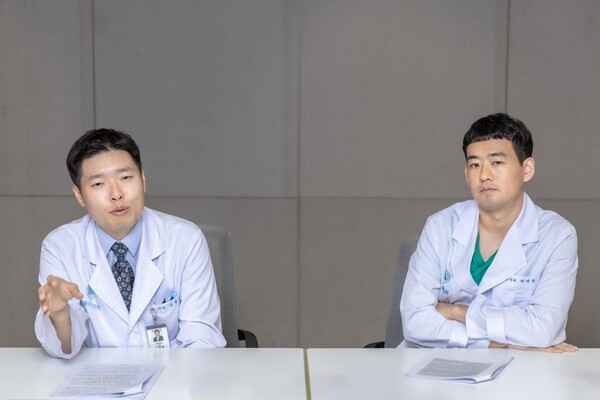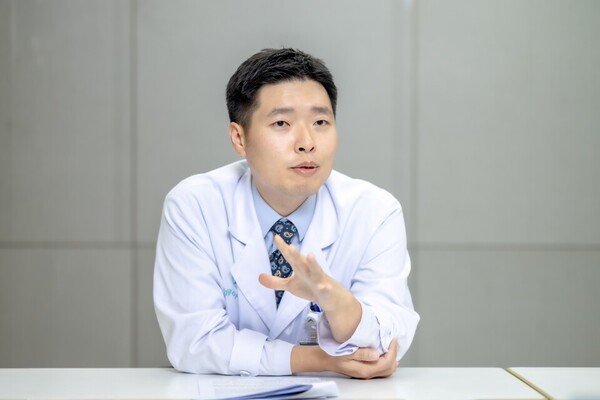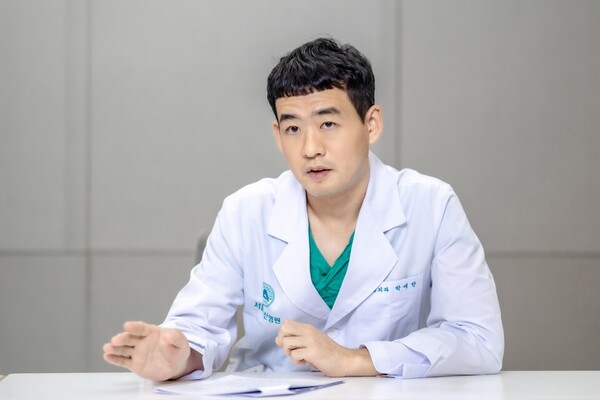Osteoporosis is a serious disease that requires aggressive treatment. Still, many patients miss the time to seek treatment because the symptoms are not obvious.
According to the “2023 Osteoporosis Public Awareness Survey” conducted by the Korean Society for Bone and Mineral Research (KSBMR) on more than 1,000 women in their 50s and 70s, 62 percent knew about the bone mineral density (T-score), a key indicator for diagnosis. Only 23 percent knew their bone density level.
Even more concerning is the state of treatment.
According to the KSBMR’s “Osteoporosis and Osteoporotic Fractures Fact Sheet 2023,” only 37 percent of people are prescribed osteoporosis medication within a year of a fracture. The “fracture domino” phenomenon in high-risk patients is a serious concern, with about 40 percent of women who experience a fracture suffering a second fracture within two years.
Fortunately, new treatment options have recently become available for these patients, allowing for more aggressive and effective treatment. In particular, the emergence of dual-mechanism therapies that promote bone formation and inhibit bone resorption simultaneously has expanded treatment options for patients with complex risk factors, such as those who are unresponsive to existing therapies or heart and liver transplant patients.
Korea Biomedical Review met with Professors Kim Chul-ho and Park Se-han of the Department of Orthopedic Surgery at Asan Medical Center to learn about treatment strategies and the latest therapies for patients at high risk of osteoporotic fractures.

KBR: What is the fracture risk and recurrence rate of osteoporosis patients in Korea?
Prof. Park: Spinal fractures caused by osteoporosis are difficult to recover fully from even after treatment. You can recover to the point where you can walk and do your daily activities, but it is difficult to return to your pre-fracture condition. Therefore, prevention is the most important. However, most patients with osteoporosis do not recognize the need for treatment because they do not have any symptoms.
Prof. Kim: Existing studies have shown that about 40 percent of female patients who experience a fracture suffer a second fracture within two years. In a retrospective analysis by the Health Insurance Review and Assessment Service (HIRA), 17 percent of patients with osteoporotic fractures experienced additional fractures within two years. According to 20 years of data from Asan Medical Center, 3.9 percent of 4,550 patients who underwent surgery for a hip fracture were readmitted for a contralateral hip fracture within three months. When other sites, including the wrist or spine, were included, the re-fracture rate within three months was about 5 percent.
KBR: What are the typical characteristics of osteoporosis patients you see in your practice?
Kim: The spine and hip are the most common sites for osteoporotic fractures. As a tertiary care hospital, we often see patients who have already suffered fractures, especially hip fractures, and most of them are in the ultrahigh-risk group for osteoporotic fractures.
KBR: What are the criteria for categorizing people at high risk of osteoporotic fracture?
Kim: The World Health Organization (WHO) defines osteoporosis as a bone mineral density score of -2.5 or less in men over 50 or postmenopausal women. Patients with osteoporosis are further categorized into low-, intermediate-, high-, and ultrahigh-risk groups.
The criteria for ultra-high risk vary slightly from guideline to guideline, but the U.S. Endocrine Society and the U.S. Association of Clinical Endocrinologists (ACE) guidelines combine the following: two or more fractures, a fracture within the last 12 to 24 months, and a T-score of less than -3.0.
In Korea, the Korean Society of Osteoporosis (KSO) and the KSBMR have slightly different guidelines, but in common, they define ultrahigh risk as having a T-score of less than -3.0, low bone mineral density (BMD), two or more fractures, and a recent fracture.
Park: An ultrahigh-risk person is also defined as having a 30 percent or greater risk of major osteoporotic fracture on the Fracture Risk Assessment Tool (FRAX), a fracture risk prediction program, or having a T-Score of less than -3.0 and a fracture while on osteoporosis medication. Older and ultrahigh-risk adults are at increased risk for multiple fractures and internal complications, and mortality tends to increase with the number of fractures.
KBR: How does the treatment of these people differ from that of the general osteoporosis population?
Kim: Osteoporosis is a chronic disease that requires lifelong management, just like diabetes or hypertension. The general principle of osteoporosis treatment is to start with a mild drug and continue it for life. This is because it can be difficult for patients in their 50s and 60s to maintain long-term treatment if they start with stronger drugs. On the other hand, people at high risk of fracture need to increase their bone density quickly. Hence, an initial intensive dose of strong medication followed by maintenance is effective.
KBR: Which osteoporosis drugs are used to treat ultrahigh-risk patients?
Kim: Osteoporosis drugs are divided into osteogenesis stimulators, which build new bone, and bone resorption inhibitors, which stop bone loss. The most potent is Evenity Injection (romosozumab), one of the osteogenesis promoters. There are also parathyroid hormone (PTH) drugs represented by Forsteo (teriparatide). When I need a stronger drug, I focus on Evenity, Prolia (denosumab), and zoledronate.
Park: Osteogenesis stimulators are more effective, but you must consider the cost-benefit ratio depending on the patient's condition. Evenity is more effective than parathyroid hormone preparations, which are also osteogenic agents, especially in increasing spinal bone mineral density. Patients who already have a fracture or are at high risk due to other conditions may benefit from treatment with Evenity and should be considered after full counseling. For the treatment of very high-risk patients, Evenity or teriparatide should be presented as treatment options and discussed with the patient.
KBR: What are some of the key clinical study findings for Evenity that are particularly noteworthy?
Park: Evenity is effective in three major clinical trials -- ARCH, FRAME, and STRUCTURE. In the ARCH study, women with postmenopausal osteoporosis were compared to alendronate, and after 12 months of treatment, the risk of vertebral fracture was 37 percent lower in the Evenity arm (p=0.03). Bone mineral density gains were also 8.7 percent greater at the lumbar spine and 3.3 percent greater at the total hip than alendronate (p<0.001).
The STRUCTURE study compared to teriparatide also showed superiority for Evenity. After 12 months of treatment, bone mineral density gains were 3.2 percent higher at the total hip and femoral neck and 4.4 percent higher at the lumbar spine in the Evenity arm than teriparatide (p<0.0001).
KBR: Have the benefits demonstrated in clinical studies been confirmed in real-world practice?
Kim: The effectiveness of osteoporosis drugs is evaluated in terms of increased bone density and reduced fracture risk. Fracture risk reduction is difficult to see in clinical practice, but the causal relationship between increased bone density and reduced fractures has been proven in research.
Evenity has demonstrated clear bone density benefits in the clinic, making it easy to explain to patients. In the FRAME study, Evenity demonstrated greater bone mineral density gains in postmenopausal women with osteoporosis than placebo or other agents. A randomized controlled trial in the New England Journal of Medicine (NEJM) also confirmed the most effective increase in bone mineral density.
Park: Evenity has shown effective bone density gains in patients who have not responded to other agents. Even patients with reduced kidney or liver function can complete treatment for a year without any adverse effects, making it a safe and effective agent.
I frequently prescribe Evenity to liver and heart transplant patients. Transplant patients are at high risk for osteoporosis, where multiple vertebral fractures are common due to decreased organ function and the use of high-dose steroids and immunosuppressants. In these cases, Evenity is often used as an emergency treatment.

KBR: Is there any difference between Evenity and other osteogenic agents?
Kim: In the category of osteogenic agents, Evenity is one of the two most important agents along with parathyroid hormone. Both are highly effective in improving bone density, but the difference is that Evenity has a dual mechanism of action that promotes bone formation and inhibits bone resorption.
The goal of increasing bone density is to prevent fractures. While both drugs are considered effective in reducing the risk of vertebral fractures, there is a difference in hip fractures. Evenity is the only osteoporosis drug, and multiple published studies have shown clinical evidence for hip fracture prevention.
While the spine is theoretically composed primarily of soft cancellous bone, the hip joint is composed of hard cortical bone. To increase bone density in the cortical bone, it is speculated that Evenity's dual effect of promoting bone formation while simultaneously inhibiting bone resorption would be more effective. For this reason, Evenity tends to be preferred (for hip fracture prevention).
Also, there are significant differences in dosing between Evenity and PTH preparations. PTH can be prescribed for several months' worth of doses at a time, rather than requiring patients to self-inject into their belly every day, while Evenity requires patients to visit the doctor once a month for injections. These differences have divided patient preferences.
KBR: Have you experienced any side effects or adverse reactions when prescribing Evenity?
Park: To date, there have been no major adverse events or restrictions on use due to Evenity. In the early stages of development, there were concerns about cardiovascular risks, but subsequent clinical studies and real-world data (RWD) showed no significant differences compared to other agents. Based on this evidence, Evenity is recognized as a relatively safe agent.
Kim: Evenity is considered a safe agent. It is becoming an important treatment option for patients with jaw osteonecrosis who cannot stop treatment due to low bone density.
KBR: What is the follow-up treatment after a year of treatment with Evenity?
Park: After a year of treatment with Evenity, maintenance treatment is essential; otherwise, bone density will decrease again. The choice of oral or injectable treatment depends on patient preference and circumstances. Studies have shown that switching from Evenity to Prolia achieves the best results in maintaining bone density and reducing fracture risk.
This was also confirmed in a comparison study with bisphosphonates. After 12 months of treatment with Evenity, the Prolia sequential treatment group had significantly greater increases in the lumbar spine and hip bone mineral density than the zoledronate sequential treatment group.
Kim: Sequential therapy is an important concept in osteoporosis treatment. There is a lot of discussion in the literature about which drug to continue with after starting a particular agent. Studies have shown that continuing with a stronger bone resorption inhibitor is more effective than discontinuing it after using Evenity. One of the most recommended is Prolia. It requires a clinic visit every six months for an injection but is preferred because of its maintenance effectiveness.
KBR: Evenity requires 12 injections over a year. It's not easy to convince patients and caregivers to do this. What percentage of patients complete the 12 injections?
Kim: Patients who are prescribed Evenity are often in a very serious condition, and most of them are aware of their situation. If the importance of the medication is fully explained at the beginning of treatment, adherence is higher. We emphasize that it is the most powerful drug available and that it can only be used 12 times a year.
Costs have also decreased significantly. Even if not covered by insurance, it costs about 250,000 won ($170) monthly, less of a financial burden than it used to be. And because it requires monthly visits to the clinic for injections, patients tend to stick with the treatment. In contrast, traditional oral medications are often discontinued by patients due to digestive side effects.
Park: One of the main reasons for preferring Evenity is the high level of adherence. When we fully explain the need for a one-year treatment, patients rarely stop once they realize they need it. In our experience, more than 90 percent complete the one-year treatment.
Teriparatide, on the other hand, has relatively low adherence. Even when started after adequate explanation, it is difficult for elderly patients to maintain daily self-injection for long periods, resulting in early discontinuation. In these cases, ongoing persuasion and explanation are required. Still, with Evenity, adherence is very high once the need is recognized early on, as there is a clear one-year treatment window.

KBR: What do you think needs to be done to improve the osteoporosis treatment environment?
Park: Although insurance criteria have been relaxed recently, there is still a tendency to rely too heavily on bone density levels. However, bone density alone is not a complete assessment of fracture risk. Even if you have good bone density, your risk of fracture can vary greatly, depending on your underlying medical conditions and whether you take medications that cause osteoporosis. There is a need for insurance criteria that more closely reflect an individual's risk of fracture.
While the threshold for reimbursement of osteoporosis drugs has recently been lowered from a T-score of -2.5 to -2.0, maintaining treatment still presents challenges. Patients who improve on treatment often benefit from continuing their medication but are forced to switch to full co-payment. Maintenance treatment needs to be more flexible and reflect the individual circumstances and fracture risk of the patient.
KBR: Do you have any memorable patients in your practice?
Park: A patient with osteoporosis and renal failure is particularly memorable. The patient with renal failure could not use the parathyroid hormone, so we prescribed Evenity to reduce the risk of complications. The patient was at very high risk of osteoporotic fracture and had a 30-40 percent risk of postoperative mechanical complications but has had a stable outcome for one year. This case confirms that Evenity can be used effectively before and after surgery. Although there is a lack of clear evidence, this is an impressive example of a high-risk patient in the perioperative period with good results.
KBR: What is your message to osteoporosis patients and healthcare providers?
Park: I would like to emphasize that it is difficult to fully recover once osteoporosis results in a fracture, no matter how well it is treated and managed. Even a simple compression fracture is very likely to result in chronic back pain in the future.
Therefore, it’s important to have regular examinations to check your condition and not ignore it even if you don’t have any symptoms. Think of it in the same way as hypertension or diabetes, which have no immediate symptoms but can cause serious complications if they become chronic. In the end, regular checkups, active participation in treatment, and prevention are key.
Related articles
- Women’s hesitation to seek menopause treatment risks long-term health
- Daewoong and Celltrion Pharm to co-promote osteoporosis drug CT-P41
- Korea United Pharm to export osteoporosis drug to Myanmar
- Urgent action needed to address rising osteoporosis-related fractures in Korea’s aging population: IOF chief
- AI predicts fracture progression in patients with spinal osteoporosis

